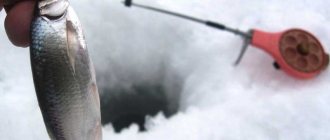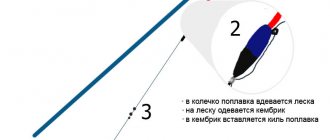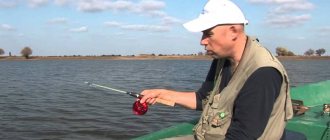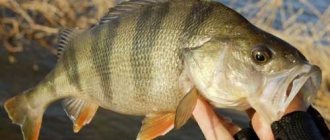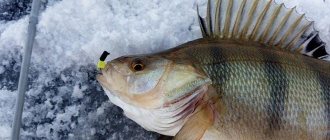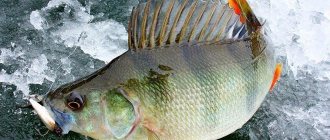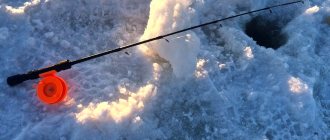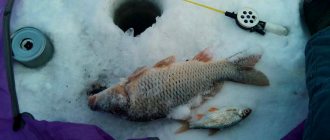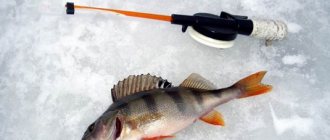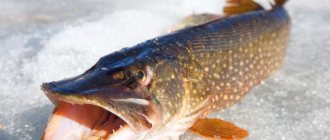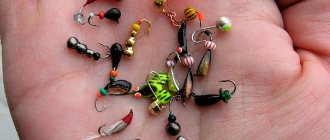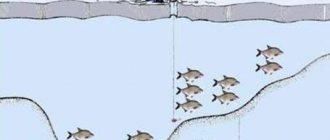The tricks of catching perch with bloodworms in winter allow the angler to achieve better results day by day, unlike those amateurs who prefer to neglect them and remain without that stunningly impressive catch, which guarantees the application of all these secrets in practice.
In this article we will share with you the existing unspoken rules of interaction with various types of jigs, spinners and other baits, which allow you to both significantly reduce the time to achieve a catch and increase its overall quality.
Let's admit right away - there is nothing complicated about this, and if you do not neglect our advice, then with a 99% probability you will achieve real success in catching perch during ice winter fishing.
How to prepare bloodworms
In winter, the use of high-tech modern gear is very difficult, and that is why fishermen prefer to use bait in the form of various live baits. These are, as a rule, mosquito larvae and other small things that can attract the attention of redfin fish with a rather moderate appetite at this time of year due to the lack of desire to leave the relatively warm regions of reservoirs near the bottom.
One of the most beloved by both fish and those who catch them is the bait in the form of dragoon mosquito larvae, which are attractive and appetizing for any type of underwater ichthyofauna (except perhaps for its largest representatives like large pike and other super-predators ), so inconvenient for mounting. Their skinny, flimsy bodies are not at all designed for these purposes, and anglers often have problems getting a hook through them.
Beginning ice fishing enthusiasts have questions about how to prepare bloodworms in the evening. The answer to this is simple: first of all, you will need a container made of foam material for storing various types of materials, visually reminiscent of foam plastic.
This container needs to be treated with iodine. You can take a simple iodized pencil, which costs mere pennies in almost any pharmacy, and draw a grid on the inside surface of the box. Next, lay out the larvae exactly in the quantity that you will need the next day.
The point is that the jig will already be attractive to the eyes of the river striped robber, but overnight it will infuse and become saturated with iodized smell, which will make its “popularity” among the perch increase several times!
Review of ready-made baits for winter
To all baits, no matter ready-made or homemade, you should always add a nozzle and bait with which you are currently catching, for example, a handful of bloodworms.
Usually four types of branded Dunaev winter mixtures DUNAEV-READY are used. Here you can immediately mention “ Universal ”. It is usually used on all types of winter fish. The bait is dark brown in color. This mixture resists frost well, that is, it does not freeze as quickly as other mixtures. It also does not spoil for a long time. And this is what is called “rancid” bait, which will not attract fish, but will rather scare them away.
Tips for fisherman: Do-it-yourself ice drill for winter fishing - What is the difference, pros and cons
The “Motylnaya” bait attracts winter fish very well, but it should be taken into account that along with peaceful fish, predators can also approach the hole. This bright red bait contains about 10% natural bloodworms.
The bait mixture "Bream" has an excellent ability to lure bream to the hole, but there is one unpleasant moment. This ability of this bait may not manifest itself in all reservoirs. This must be verified experimentally.
The bait "Roach" is also universal. It attracts almost all fish, but it contains components with a dusting effect. Therefore, small things can also fit into the hole.
Fishermen are often concerned about how to properly store bloodworms so that the fish will enjoy them for as long as possible. Storing bloodworms at home is quite difficult. It crushes easily, but there are several ways to keep the bloodworm alive. These methods are somewhat similar.
Photo 1. Extraction of bloodworms.
This method is not the only one. Catching bloodworms can be done in a gauze cloth with large holes or in a thin-woven bag. The trick is that you need to put a piece of fish, meat and a weight in the bag that allows you to lower it to the very bottom. After several hours, the bag is removed from the water, and the accumulated larvae are collected by hand.
Experienced fishermen advise how to catch bloodworms on a device such as a string. A fishing line or wire is pulled tightly onto the frame and used to comb the bottom of the reservoir. The strings touch the larvae, and they wrap themselves in rings around them. Then the rings are washed off into a tank or bucket of water. Unfortunately, this method damages many larvae.
When sorting, the bait should be placed in a fine-mesh sieve. Then the sieve should be immersed in a container that is first filled with water. After a short period of time, small larvae will crawl through the cells into the container, but large ones will remain.
At the selected location, a hole is cut approximately 1.00 - 1.50 x 1.00 - 1.50 meters. The hole can be cut with a sharp hatchet. During the cutting process, the resulting crumbs are immediately removed from the future ice hole. Until the edges are cleaned, water should not be allowed to enter the hole. If the water rises, further cleaning of the ice hole becomes an unpleasant task. For such circumstances, it is necessary to provide a tool like an ice pick.
Tackle for fishing with bloodworms
When it comes to selecting gear for use in jig fishing, it should be noted that the fishing line should be thin enough. This is primarily due to the very fragile body structure of this live bait. One wrong move, and the larva can fall apart in two or even leak out without a trace, depriving you of your catch.
The problem is that you will find out about this after 10-20 minutes, when you decide to make sure that everything is in order with the gear and pull it out of the hole. In all other cases, the criteria for choosing gear are the same as for any other winter fishing. There are no secrets other than advice on using the smallest gear for a given case. This is the main trick to catching perch with bloodworms in winter.
You will also, as always, have to rely on the simplest plays of the fishing line, either lowering it to the very bottom so as to disturb the silt (this attracts perch in 90% of all cases), then suddenly suddenly raising the steel body upward, on which a thin thread once reddens. a living creature, which has now become just food for large-mouthed fish, which is eternally gnawed by only one feeling of insatiable eternal hunger, which forces it again and again to awaken from hibernation and go out on a dangerous, but so necessary hunt.
How to choose a jig and nod
Different types of jigs are sold in fishing stores - there are jigs for fishing with a nozzle and jigs without attachments (reelless jigs).
Tips for a fisherman: How to properly tie a jig to a fishing line - How to best use it
The most universal form in fishing with a jig with bloodworms is considered to be an ordinary lead “ovinka”. Some fishermen make them themselves. It is enough to solder a drop of lead onto a small sharp hook so that you can catch perch with such a homemade product. Some anglers carry only one type of jig with them when fishing, approximately the same weight per gram, but with different hook sizes.
It is worth saying that the shape of the jig is not as important as its weight and diameter , and even more so the hook, which must be sharp! Fishing with a jig: What is more important - the game of the jig, the shape and size or the attachment. If you fish in reservoirs without a current, then usually the optimal diameter of a tungsten jig falls within the range of 2-3 mm, and a lead jig - 3-4 mm. The standard weight of both is 0.2-0.3 g. For fishing in the current, you may need jigs of 1 gram or more, but a beginner should avoid such fishing.
table depending on the depth at the fishing site, the expected size of the fish, the degree of its activity, the diameter of the fishing line and the mass of the jig
Fish size, g
Line diameter, mm
Weight of jig, g
The first option is the clothespin hook already mentioned above, ideal for using small bloodworms. It consists of two halves connected by a spring. When the spring is pressed, the hook opens. It is enough just to immerse it in a container with bait and release the pressure - and several larvae will probably remain trapped in the structure.
Tactics for catching bloodworms with a jig
Most novice fishing enthusiasts are little aware that almost half of the success in this matter depends on how competently and skillfully the so-called tactical game with bait is carried out. This is an extremely important point that is often overlooked by most beginners. In order to completely eradicate this omission within the framework of this article, we will share with you some recommendations regarding the rules of playing the right game. So let's get started:
- The jig first slowly sinks to the very bottom, where it remains in a lying position for 5-10 minutes, after which it abruptly breaks off from the bottom and rises to the top, again for the same 10 minutes, which must be sustained in order to be sure attract potential predators throughout the area.
- This time everything happens in the same way as in the first case, only the waiting time is reduced by about half. This method is suitable for catching more frisky, energetic fish (which in winter is, however, very unlikely, because it is at this time that the perch shows itself to be the most lethargic and does not actively rush for even the most seemingly appetizing bait, sometimes ).
- The live bait needs to be immersed to the very bottom and periodically raised to a height of 5-10 centimeters, tapping it on the bottom over and over again, which will cause a small wave of sand to rise, to which the striped critters living nearby should immediately react.
- The hook sinks to the very bottom, after which it rises 20-30 centimeters and then a not quite typical action follows - you need to tap your finger on the fishing line for two to three minutes or more until the first results appear. According to some experts, such an atypical approach may well please the brave experimenter, whose consciousness has not yet had time to acquire pernicious stereotypes.
- The bait in this case is located at the top - near the surface. This is complemented by frequent twitching of the fishing line up and down. These actions are capable of attracting, as a rule, not the largest prey, but in the absence of fish, as they say, cancer is fish, right?
Don't neglect these tips from experienced regulars of ponds. Experience is a worthwhile thing, especially when it comes to such a rather conservative thing as fishing. If not everything, then certainly a lot depends on playing with tackle, and it can be called a real discipline within this hobby itself, which is so ardent and close to the hearts of half of the male (and not only) population of the globe.
Delicate bait
Bloodworm is an extremely delicate bait, and even a tiny wound on it risks rendering it completely unusable, because Instead of a juicy larva, only its shell will remain on the hook. To prevent this from happening, the hook on the jig should be:
- as sharp as possible
- thin enough
- with a relatively small sting.
However, a hook that is too thin is also not very good, because... even a small fish will be able to pull the larva off the hook without any problems, without even getting hurt. This happens because through an extremely thin hook, like a sharp knife, it cuts the bloodworm, and it ends up in the fish’s mouth. With a thicker hook, this trick will not work; it will hold the bloodworm on the hook, and the fish will have no choice but to swallow the treat along with it.
Tips for fisherman: How to properly attach maggots to a jig in winter - Choosing the best
To prevent fish from pulling off the larvae, the bloodworm should be placed in a “ring”
And if the hook tip is too large, then the bloodworm “juice”, which is attractive to fish, risks leaking out before the bait sinks into the hole.
Winter fishing for bloodworms is one of the favorite types of ice fishing among anglers. Surely many fans of ice fishing have at least once held a bloodworm in their hands and could not imagine winter fishing without a jig. Anglers use bloodworms to catch different fish in many bodies of water and in a variety of ways.
Winter fishing for bloodworms is one of the favorite types of ice fishing among anglers. Surely many fans of ice fishing have at least once held a bloodworm in their hands and could not imagine winter fishing without a jig. Anglers use bloodworms to catch different fish in many bodies of water and in a variety of ways.
It’s just that many winter fishermen, especially those who are just starting out, do not know how to properly attach a bloodworm to a jig. At first glance it seems simple and easy. But, only at first glance, in reality everything is not so simple.
There are certain rules for fishing with bloodworms:
There are certain rules for fishing with bloodworms:
Methods for planting bloodworms:
Classic.
- The simplest method that allows you to use several larvae. The hook is inserted between the head and body of the bloodworm and pierces it right through, so you can attach several larvae to it in order to hide the sting of the hook. The method is designed for the fact that most fish swallow the entire bait completely.
- The classic method, the bloodworm is pierced in the head part, but the hook must be hidden in the head of the larva so that it is not noticeable to the fish.
- “Ring” - this method is used when the bite is bad, when even small fish do not bite. With this method, the bloodworm is pierced in the head part, then the tip of the tail is added to the hook, thus forming a ring.
- The “Stocking” method is a rather labor-intensive planting process, since bloodworms can leak very easily. The body of the bloodworm is pierced near the head, then the hook is led towards the tail of the larva. The name of this method comes from the fact that it is similar to putting on socks. The method is difficult for people with poor vision and those who do not have sufficient experience working with small parts.
Sports.
- The sporty attachment method guarantees an excellent bite for fish of any size. The sting of the hook is inserted between the fifth and sixth rings of the larval body, i.e. approximately into the middle of the bloodworm. The hook is turned and inserted towards the head or tail of the larva. The name comes from the fact that this method of baiting is usually used in competitions.
- “By the belt”, the hook is inserted into the body of the bloodworm between the fifth and sixth rings and then brought out. The method is used for active biting of perch and roach. It is believed that in this form the bait looks most attractive.
Bun.
- Beam baiting is a method used when catching large fish on a large hook. A large bunch of bloodworms secrete juice, which is most attractive to fish. To do this, you need to take several larvae, up to 10 pieces, tie them with thread, and then put them on a hook. It is not very convenient to work with thread, especially in winter, so they mainly use a special device - a bundle knitter. This device can be found in fishing stores. In appearance, it is a device with special paws that push the elastic band apart, and then, when the larvae are placed in it, it clamps it to the required size.
Bloodworms work effectively as bait in bodies of water with little current, when the larvae move under its influence. An excellent bite using bloodworms occurs when fishing for roach, bream and tench. Half the success of good fishing lies in the fisherman's knowledge of how to hook bloodworms. With all the variety of methods, you can choose the most successful method for yourself.
How to plant bloodworms?
Bait for fishing with bloodworms
Dead dragoon mosquito larvae are used as the main food. It is much more profitable and easier to use what you purchased in a specialized store than to spend additional resources, which in any case will not be so attractive to freshwater “ichthyosaurs”, which happen to have red fins and a “tactical” striped color.
Everything is simple here - the dead larvae are thrown into the hole and thereby attract potential observers from among seasoned humpback whales and numerous eaters of dead flesh, in the person of slightly smaller, but much more numerous brothers of these same owners of an outstanding hump, crowned with a tall and rather spiky crest .
On this positive note, we can say with a certain degree of confidence that all the tricks of catching perch with bloodworms in winter are over. Now the success of the enterprise itself depends solely on you and on the ability to use the information received in practice.
